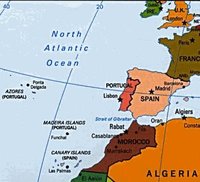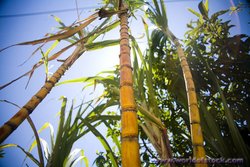Floresta Laurissilva da Madeira, Portugal
| Topics: |
Contents
- 1 IntroductionFloresta Laurissilva da Madeira - Forêt Laurifère de Madère of Madeira, Portugal is a World Heritage Site located at 32°46N/17°03W. (Floresta Laurissilva da Madeira, Portugal)
- 2 Geographical Location
- 3 Date and History of Establishment
- 4 Area
- 5 Land Tenure
- 6 Altitude
- 7 Physical Features
- 8 Climate
- 9 Vegetation
- 10 Fauna
- 11 Cultural Heritage
- 12 Local Human Population
- 13 Visitors and Visitor Facilities
- 14 Scientific Research and Facilties
- 15 Conservation Value
- 16 Conservation Management
- 17 IUCN Management Category
- 18 Further Reading
IntroductionFloresta Laurissilva da Madeira - Forêt Laurifère de Madère of Madeira, Portugal is a World Heritage Site located at 32°46N/17°03W. (Floresta Laurissilva da Madeira, Portugal)
Geographical Location
Located in Madeira region (the Atlantic archipelago of Madeira is an integral part of the Republic of Portugal). 32°46N/17°03W.
Date and History of Establishment
 Location of Madeira, Portugal. (Source: NASA)
Location of Madeira, Portugal. (Source: NASA) The nominated forest has a status of Strict Nature Reserve, and is part of Madeira Nature Park, created by Decree No 12/82/M of October 1982 and under protection by Decree No 13/93/M. These two decrees provide for the administration and management of the Park. Another decree, Decree No 21/89/M provides for the protection and surveillance of the Park by the Regional Direction of Forests. Inscribed as a World Heritage Site in 1999.
Area
The Laurissilva Forest covers 15,000 hectares (ha). Its buffer zone, also part of Madeira Nature Park, covers 12,000 ha.
Land Tenure
Most of the land belongs to the regional Government of Madeira. State (7%), Community land (90%), Private land (3%).
Altitude
The forest is between 600 meters (m) and 1,300 m altitude.
Physical Features
Madeira archipelago is composed with four main islands, volcanic in origin. It lies 600 kilometers (km) from Africa (Morocco). The slopes rise steeply to a maximum volcanic peak of 1,862 m high on Madeira. The Laurissilva forest, crossed by many rivers, streams and waterfalls occupies 20% of Madeira Island on the abrupt hills and sides of mountains in the north.
Climate
No detailed information. The north is more cooler and humid than the south, due to North-eastern winds, giving typical cloud cover.
Vegetation
Most of Madeira was forested when it was discovered in 1419. At present, human habitation is most dense around the south coast, where the slopes are cultivated up to 1,200 m. To the north of the island there remain large tracts of the original Macronesian laurel Laurus forest, composed mainly with trees of Lauraceae family and some forms of ferns from the Miocene and Pliocene periods, 20 million years ago. These forms are now extinct in Europe due to climatic alterations during glacial periods and survived only in Macronesian archipels. According to the nomination document, Madeira forest is known as the largest Laurissilva forest in the world.
A total of 150 plant species occur in the forests, most of them being endemic to Madeira.
Fauna
 Sugar cane plant. (Source: Princeton University)
Sugar cane plant. (Source: Princeton University) The fauna is relatively poor, but most species are of conservation concern, mainly as endemic to the island. The following bird species occur in the Laurissilva forest: Accipiter nisus, Apus unicolor and Fringila coelebs maderensis. Mammals and reptiles are particularly poor: two species of mammal Nyctalus leisleri verrucosus and Pipistrellus maderensis, and one species of reptile Lacerta duguesii are reported.
Cultural Heritage
No detailed information. The Island of Madeira was discovered in 1419 by the Portuguese navigator Joao Gonçalves Zarco. The 16th and 17th centuries were characterized by high production of sugar.
Local Human Population
Approximately 500 people live in the buffer zone of the forest. The site is not inhabited inside. The south of the island is more populated due to a nice climate. This has lead to the total destruction of indigenous forests.
Visitors and Visitor Facilities
The nomination document mentions that thousands of tourists visit Madeira every year. Visitor facilities include films, videos, brochures and publications, car park, sanitary installations and emergency service.
Scientific Research and Facilties
Scientific research has been mainly conducted by Madeira Botanical Garden on indigenous and endemic plant species, their introduction in natural habitat. In 1992 and 1995, staff of Madeira Nature Park conducted qualitative and quantitative survey of the Laurissilva forest. Results were published in Laurrissilva da Madeira by Madeira Nature Park in 1996 and in Atlas do Ambiente by Direcçao Geral do Ambiente in 1997.
Conservation Value
With its 14,500 ha, the Laurissilva forest of Madeira is considered as the largest Laurissilva forest of the Macronesia Islands and present still areas of primary forest. The level of endemism in plants and animals is reported to be particularly high.
Conservation Management
Goats and cattle have been eliminated from the Park due to the damages caused on forest, soil and vegetation. In 1980, a program to remove all exotic species (Alien species) was conducted, leading to the recovery of large area of primary forest.
The zoning and management plan defined by Regional decree No 19/82/M is still under development. The Regional decree No 12/95/M provides for the Territorial Organisation of the Autonomous Region of Madeira (Plan d'Organisation Territoriale de la Région Autonome de Madère-POTRAM), including general orientations on planning and development on use and land tenure and protection of the natural heritage and population repartition.
Management Constraints
The extension of road network and agricultural land constitute the major problems related to the development. The presence of goats in forest has caused serious threat to the forest since the colonial times.
Staff
A total of 44 staff, including 1 Director, 2 Heads of Division, 4 Senior Technicians 1 Technician, 2 Assistant technician, 6 Administration assistants and 25 Forest Rangers from the Regional Direction of Forests.
Budget
Funding from the European Economic Community for scientific projects and funds from the Regional Government of Madeira.
IUCN Management Category
- World Heritage Site: Criteria i, ii, iii, iv
Further Reading
- 10 References in the nomination document.
| Disclaimer: This article is taken wholly from, or contains information that was originally published by, the United Nations Environment Programme-World Conservation Monitoring Centre (UNEP-WCMC). Topic editors and authors for the Encyclopedia of Earth may have edited its content or added new information. The use of information from the United Nations Environment Programme-World Conservation Monitoring Centre (UNEP-WCMC) should not be construed as support for or endorsement by that organization for any new information added by EoE personnel, or for any editing of the original content. |